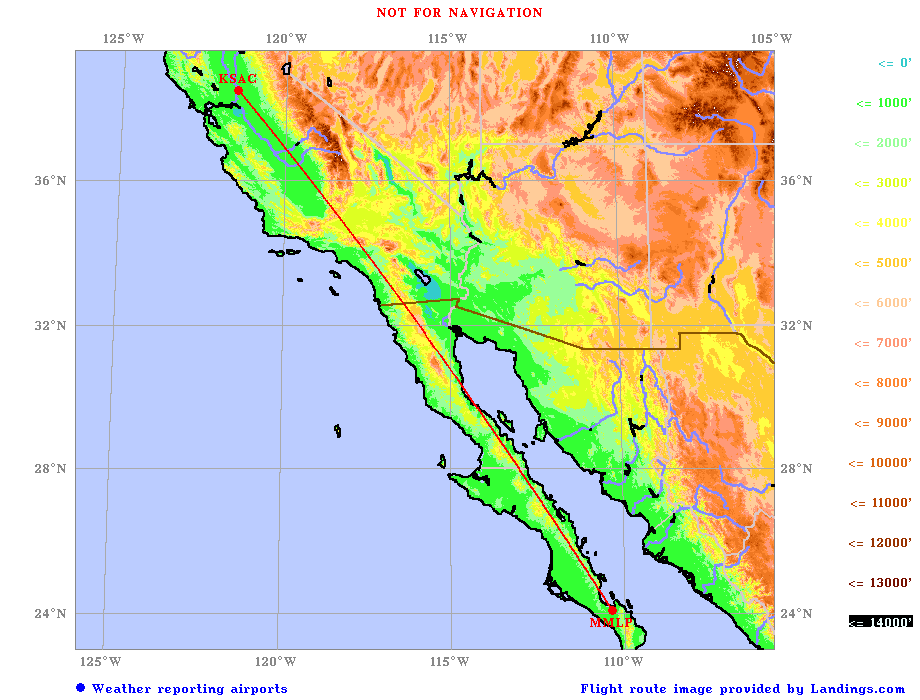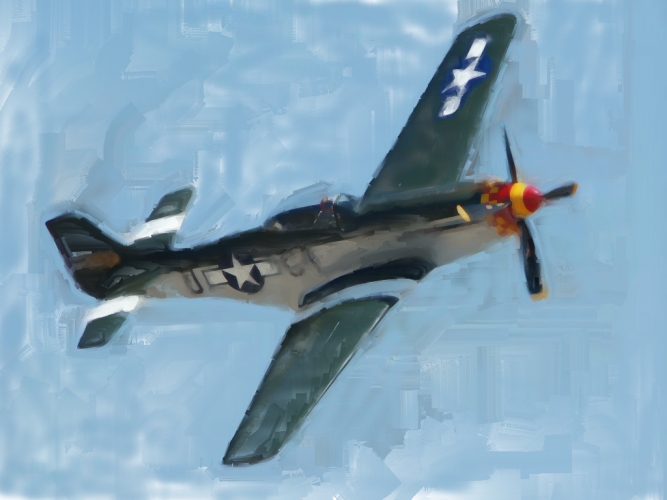

After having been home a few months and recuperated from having gone round the world in my Corsair, a World War II fighter, I started thinking about the Southern route. Many planes transferred from the States to Europe, especially the North African and Southern European Theatre, by flying across the Atlantic from Brazil to Africa. Iíd see parts of the world I had missed the first time and avoid a couple places I didnít want to see again.
I looked at the distances from island to island across the South Pacific and realized the Corsair did not have the 'legs'to make a few of those hops. That might be a problem, running out of gas over the Pacific. I knew I needed a plane with more legs. Over the winter I traded my Corsair for a North American P-51D Mustang. The P-51 was better suited to making the kind of hops I intended. It had been built to fly long distances not to land on carriers and carry thousands of pounds of bombs. The plane was built small and sleek. The engineers also did something different with the wing, moving the thickest part of the wing, called the chord, towards the back of the wing which reduces parasitic drag and made the design screaming fast with a cruise speed of 350 knots. The Mustang's design was so sleek that it had trouble slowing down enough to stay with the bombers they were escorting.
That fast cruise would allow me to take two hops in one day and still have the same time in the air when one of them was short, a real day saver on the trip. I researched the differences and one thing that stood out was the Mustang had a ferry range of about 2,200 miles with the two wing tanks, it would allow longer hops with less flying time and I would still have plenty of fuel reserve. Over those long lonely stretches across the Pacific a little extra fuel would be a big comfort.
I did the same upgrades to the Mustang as I had the Corsair: modern avionics, replaced the antiquated oxygen system, and I stripped the 50 calibers out of the Corsair and put them in the Mustang.

There were some issues but lady luck was with me and I got the whole thing flight planned. One thing I did in the planning was to allow more time in the flight plan for staying over at stops. I had learned that several days of long hops left me drained physically and mentally, so I planned in more multiple day stops to let my batteries recharge.
The day I was supposed to leave came up much too quickly. If I hadnít done this once before, I would never have gotten everything done in time. The plane was ready; I had the clearances to the various countries, I had the maps and en route procedures, I was ready as the morning sun was just peeking above the mountains when I started that big Rolls-Royce designed engine. Yes, the US plane had a British engine. The only similar American engine, the Allison, was a piece of junk compared to the Packard built and designed by Rolls engine and the later P-51s were fitted with the Packard built engine. The heavy rumble bounced off the concrete and filled the air as the blue smoke was blown aft by that big paddle-bladed propeller. I called into Ground control and got taxi permission from my hanger out to the end of the active runway, 20. The controller cleared me to the end of the active runway. By the time I got there, the engine oil was heated and everything was reading in the green. I switched the radio to the tower frequency and asked for a straight out departure. I ran up the engine and checked the magnetos, got permission for departure, taxied out to the center of the big concrete runway, applied throttle, and in seconds the Mustang lifted off from the runway and climbed up and away.
I climbed up to 15,500 feet and contacted ATC. Even though I was flying VFR I would be flying through Los Angeles air space on my way to Baja. I asked for VFR Flight Following and was told to squawk 1347. I know that seems high for a prop plane but there is a speed limit of 250 knots below 10,000. So if I wanted to cruise efficiently at 350 I had to get above that altitude and into the thinner air up higher. I settled back and cruised down that long boring valley. At the southern end of the valley I veered just a little to the west to go through the gap in the mountains where highway I5 cuts through the mountains. That is an easy landmark to follow.
ATC handed me off to LA Approach so I changed frequency and they gave me a new squawk. One of the things I had learned to do was when I got handed off to a new ATC, was to tell them I was a student pilot. Thatís because the ATC people talk so fast unless you are doing this all the time, you canít follow them. They slow down for student pilots. I read that in the heavies, i.e. commercial jets, the pilot not flying is the one on the radio because it all goes so fast the guy flying canít do the radio and fly the plane. I believe it. And I know the ATC folks have to talk fast especially in the congested air space around major airports because they have so many planes they have to be bang-bang-bang. But for us poor VFR pilots not used to it, they talk too damn fast. I had to wonder if they really believed a student was flying a Mustang but the girl did slow down when she talked to me.
Once over the mountains I flew out over the big LA basin and stayed at 15,500 feet. About 10 minutes later, the ATC came on and asked if I could descend to 9,500 feet. I looked around and didnít see anyone else. But then I thought, why would she ask? Because there are big jets coming from the east and descending into LA? I didnít have any desire to fight with them but I also wanted to maintain my speed. I came back asking for clearance to maintain 350. I knew the ATC had no desire to allow me to fly that fast that low. If something happened they would blame the deviation from regulations whether or not that had anything to do with it. I've read accident investigations where they blamed the pilot for having an out of date chart even though nothing on the chart had changed and he was flying at his home airport. She gave me a vector slightly east. I guess she decided to route me around the heavy rather than allow a violation for allowing me to fly Ďtoo fast.í
I stayed level at 15,500 feet while looking around to see if there was another craft in the area. It was a nice day in LA; you could see the ground through the smog. I got handed off a couple times, getting a new 4 digit squawk each time, as I went south. I watched as San Diego slid by off to the west and I knew I was flying out of US airspace. I could imagine the lines at the border, but there was no immigration control at fifteen thousand feet. It is a funny feeling knowing you are now in a different world. I had learned how different the rules could be. There was a moment of faint unease, but it soon passed and was replaced by the elation of setting off to do something so unusual. How many people had ever done what I was about to do? I just read the other day a company is selling flights to the moon, current price $30 million. One man has signed and they need a second person. The advertising draw is only 24 people have ever been there. So I know the pull of doing something few have done is strong.
I crossed the little arm of Baja and set off down the Gulf side. The water was a beautiful pale blue. It was the season for the grey whales to be in the gulf so I kept a look out. I thought I saw a few in the shallow waters and maybe even one breaching, but I was a little high for sight seeing.
La Paz Mexico is a medium sized city, a harbor, on the Gulf of California. The airport is to the southwest. The one thing I didnít like about it is that there was no separation between the big planes and the little planes. They even used the same parking apron. I didnít like the idea of one of those commercial jets running up their engines and flipping my plane onto a wing tip. I made sure it was chained down well when I got out.
Where I trained, there was a former Air Force base that had been turned over to the city. It had a two mile long runway and didnít have a manned control tower anymore. It was perfect for certain kinds of training, like landing practice, flying the plane one foot over the runway and holding it steady. You could do that for two miles.
The thing is, big cargo jets would also use the same runway. I remember once landing and turning off the runway and having a 707 go rumbling by as he landed right behind me. A Cessna feels pretty damn small as a 707 goes screaming by. I hadnít liked it then and didnít much care for it now.
I bedded down the plane, got it fueled, and grabbed a taxi for the city. I had learned to fill up the fuel the night before. By filling the tanks with fuel, you got the air out. Air has water vapor which can condense out in the tank and drip down into the fuel. Airplane fuel does not mix well with water and it can stop an engine. I would never have thought of something like that until I started flying myself. There are a million little things that pilots have to learn.
I didnít know which would be more death defying: a Mexican taxi or a bus. I chose the taxi since it would be faster and therefore Iíd be exposed to the grim reaper for less time. The cab dropped me off near the harbor at a nice little hotel. I checked in, took a shower, and grabbed a couple tacos from a stand before joining the locals for the siesta.
I woke for dinner and found a restaurant in the harbor that looked like it specialized in seafood. I ordered fish. It must have been the Baja version of Veracruz, since it was a lot of the same stuff and it was delicious. The waitress also brought cactus. Yep, cactus. I had seen these in small Mexican markets before, so I knew it was edible. But it was new to me. I have had lots of strange foods before, eel, octopus, alligator, and horse so I wasnít put off. I asked and the girl showed me how to eat it. It wasnít half bad. I tell you what; it was a hundred times better than some stuff Americans eat like Okra. Ugh. Okra, thatís like eating snot. Iíd much rather eat cactus.
I turned in early since I had another hop the next day.
Go back to the Table of Contents
Copyright Rod O'Steele © 2009, 2011